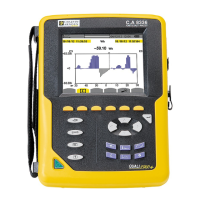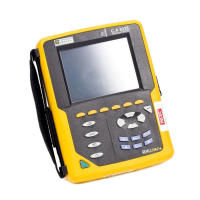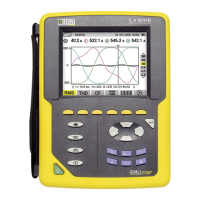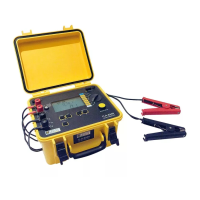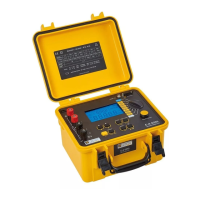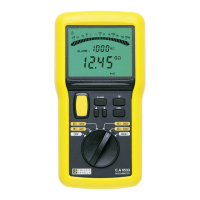Do you have a question about the Chauvin Arnoux C.A 8230 and is the answer not in the manual?
Details essential safety precautions and environmental conditions for operating the instrument.
Outlines the standard warranty period and conditions for the equipment.
Provides an illustrated overview of the instrument's key components and layout.
Explains the function of dedicated mode keys and navigation controls for menu interaction.
Details the liquid-crystal display unit and indicators for mode, battery, and status.
Describes the instrument's input terminals and its power supply options (battery/mains).
Lists available configuration sub-menus including date/time, language, and parameters.
Guides on setting the display language, contrast, and brightness for optimal viewing.
Details how to configure network connection type and current sensor parameters.
Explains how to define alarm parameters, thresholds, and hysteresis for event detection.
Overview of waveform display modes including voltage, current, THD, and peak factor.
Shows how to view minimum, maximum, mean values and simultaneous measurement data.
Provides a step-by-step guide for determining the phase order in three-phase networks.
Lists the available sub-menus for displaying power and energy-related measurements.
Explains how to start, stop, and read energy consumption measurements.
Details the process for starting, stopping, and reading energy generation measurements.
Lists the available sub-menus for analyzing voltage, current, and power harmonics.
Displays and analyzes voltage harmonic levels, phase shifts, and THD.
Displays and analyzes current harmonic levels, phase shifts, and THD.
Classifies voltage harmonics into sequences for rotating machine analysis.
Explains how to capture and store screen images for later review or transfer.
Covers displaying, managing, and erasing recorded screen grabs.
Lists options for displaying, programming, and erasing alarm logs.
Guides on defining the start and end times for alarm monitoring campaigns.
Details how to view the log of detected alarms and how to erase the entire log.
Lists available options for recording, including parameterizing and viewing data.
Explains how to set up and initiate a new recording campaign.
Guides on selecting and displaying previously recorded measurement data.
Details the function for recording starting current waveforms, including setup and viewing.
Covers initial instrument startup, welcome screen, and basic configuration steps.
Illustrates correct connection procedures for single-phase and three-phase measurements.
Explains how to display waveforms, set up alarm detection, and manage recordings.
Describes transferring data to a PC, erasing stored data, and instrument shutdown.
Covers essential maintenance advice, battery recharging, and safety precautions.
Details housing cleaning, periodic calibration, and instrument repair procedures.
Explains how to upgrade software and maintain/calibrate current sensors.
Details housing, connectors, power supplies, conformity, and environmental conditions.
Specifies reference conditions and electrical characteristics of voltage and current inputs.
Lists the specific characteristics and error margins for various current sensors.
Provides underlying formulas for calculations like RMS, harmonics, power, and factors.
Explains hysteresis principles and the four-quadrants diagram for power/energy.
Lists product part numbers, available accessories, and spare parts for ordering.
Details essential safety precautions and environmental conditions for operating the instrument.
Outlines the standard warranty period and conditions for the equipment.
Provides an illustrated overview of the instrument's key components and layout.
Explains the function of dedicated mode keys and navigation controls for menu interaction.
Details the liquid-crystal display unit and indicators for mode, battery, and status.
Describes the instrument's input terminals and its power supply options (battery/mains).
Lists available configuration sub-menus including date/time, language, and parameters.
Guides on setting the display language, contrast, and brightness for optimal viewing.
Details how to configure network connection type and current sensor parameters.
Explains how to define alarm parameters, thresholds, and hysteresis for event detection.
Overview of waveform display modes including voltage, current, THD, and peak factor.
Shows how to view minimum, maximum, mean values and simultaneous measurement data.
Provides a step-by-step guide for determining the phase order in three-phase networks.
Lists the available sub-menus for displaying power and energy-related measurements.
Explains how to start, stop, and read energy consumption measurements.
Details the process for starting, stopping, and reading energy generation measurements.
Lists the available sub-menus for analyzing voltage, current, and power harmonics.
Displays and analyzes voltage harmonic levels, phase shifts, and THD.
Displays and analyzes current harmonic levels, phase shifts, and THD.
Classifies voltage harmonics into sequences for rotating machine analysis.
Explains how to capture and store screen images for later review or transfer.
Covers displaying, managing, and erasing recorded screen grabs.
Lists options for displaying, programming, and erasing alarm logs.
Guides on defining the start and end times for alarm monitoring campaigns.
Details how to view the log of detected alarms and how to erase the entire log.
Lists available options for recording, including parameterizing and viewing data.
Explains how to set up and initiate a new recording campaign.
Guides on selecting and displaying previously recorded measurement data.
Details the function for recording starting current waveforms, including setup and viewing.
Covers initial instrument startup, welcome screen, and basic configuration steps.
Illustrates correct connection procedures for single-phase and three-phase measurements.
Explains how to display waveforms, set up alarm detection, and manage recordings.
Describes transferring data to a PC, erasing stored data, and instrument shutdown.
Covers essential maintenance advice, battery recharging, and safety precautions.
Details housing cleaning, periodic calibration, and instrument repair procedures.
Explains how to upgrade software and maintain/calibrate current sensors.
Details housing, connectors, power supplies, conformity, and environmental conditions.
Specifies reference conditions and electrical characteristics of voltage and current inputs.
Lists the specific characteristics and error margins for various current sensors.
Provides underlying formulas for calculations like RMS, harmonics, power, and factors.
Explains hysteresis principles and the four-quadrants diagram for power/energy.
Lists product part numbers, available accessories, and spare parts for ordering.
| Continuity | Yes |
|---|---|
| Diode Test | Yes |
| THD | Yes |
| Display | LCD |
| Harmonics | Yes |
